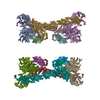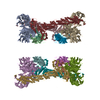+ Open data
Open data
- Basic information
Basic information
| Entry | Database: PDB / ID: 7okq | ||||||
|---|---|---|---|---|---|---|---|
| Title | Cryo-EM Structure of the DDB1-DCAF1-CUL4A-RBX1 Complex | ||||||
 Components Components |
| ||||||
 Keywords Keywords | LIGASE / ubiquitin / E3 / protein degradation | ||||||
| Function / homology |  Function and homology information Function and homology informationcell competition in a multicellular organism / histone H2AT120 kinase activity / negative regulation of granulocyte differentiation / cullin-RING-type E3 NEDD8 transferase / NEDD8 transferase activity / cullin-RING ubiquitin ligase complex / V(D)J recombination / cellular response to chemical stress / regulation of DNA damage checkpoint / Cul7-RING ubiquitin ligase complex ...cell competition in a multicellular organism / histone H2AT120 kinase activity / negative regulation of granulocyte differentiation / cullin-RING-type E3 NEDD8 transferase / NEDD8 transferase activity / cullin-RING ubiquitin ligase complex / V(D)J recombination / cellular response to chemical stress / regulation of DNA damage checkpoint / Cul7-RING ubiquitin ligase complex / positive regulation by virus of viral protein levels in host cell / ubiquitin-dependent protein catabolic process via the C-end degron rule pathway / Loss of Function of FBXW7 in Cancer and NOTCH1 Signaling / spindle assembly involved in female meiosis / regulation of nucleotide-excision repair / epigenetic programming in the zygotic pronuclei / positive regulation of protein autoubiquitination / RNA polymerase II transcription initiation surveillance / protein neddylation / UV-damage excision repair / NEDD8 ligase activity / VCB complex / negative regulation of response to oxidative stress / Cul5-RING ubiquitin ligase complex / biological process involved in interaction with symbiont / regulation of mitotic cell cycle phase transition / SCF ubiquitin ligase complex / WD40-repeat domain binding / Cul2-RING ubiquitin ligase complex / negative regulation of type I interferon production / ubiquitin-ubiquitin ligase activity / Cul4A-RING E3 ubiquitin ligase complex / SCF-dependent proteasomal ubiquitin-dependent protein catabolic process / Cul4-RING E3 ubiquitin ligase complex / Cul3-RING ubiquitin ligase complex / Cul4B-RING E3 ubiquitin ligase complex / ubiquitin ligase complex scaffold activity / negative regulation of mitophagy / Prolactin receptor signaling / negative regulation of reproductive process / negative regulation of developmental process / cullin family protein binding / hemopoiesis / viral release from host cell / somatic stem cell population maintenance / protein monoubiquitination / ectopic germ cell programmed cell death / positive regulation of G1/S transition of mitotic cell cycle / positive regulation of viral genome replication / ubiquitin-like ligase-substrate adaptor activity / protein K48-linked ubiquitination / proteasomal protein catabolic process / Nuclear events stimulated by ALK signaling in cancer / Regulation of BACH1 activity / transcription-coupled nucleotide-excision repair / regulation of cellular response to insulin stimulus / positive regulation of gluconeogenesis / positive regulation of TORC1 signaling / post-translational protein modification / intrinsic apoptotic signaling pathway / negative regulation of insulin receptor signaling pathway / T cell activation / Degradation of DVL / B cell differentiation / Recognition of DNA damage by PCNA-containing replication complex / nuclear estrogen receptor binding / Degradation of GLI1 by the proteasome / GSK3B and BTRC:CUL1-mediated-degradation of NFE2L2 / Negative regulation of NOTCH4 signaling / Vif-mediated degradation of APOBEC3G / Hedgehog 'on' state / Degradation of GLI2 by the proteasome / GLI3 is processed to GLI3R by the proteasome / DNA Damage Recognition in GG-NER / FBXL7 down-regulates AURKA during mitotic entry and in early mitosis / nucleotide-excision repair / cellular response to amino acid stimulus / Degradation of beta-catenin by the destruction complex / Evasion by RSV of host interferon responses / Oxygen-dependent proline hydroxylation of Hypoxia-inducible Factor Alpha / NOTCH1 Intracellular Domain Regulates Transcription / Dual Incision in GG-NER / Transcription-Coupled Nucleotide Excision Repair (TC-NER) / Formation of TC-NER Pre-Incision Complex / Constitutive Signaling by NOTCH1 PEST Domain Mutants / Constitutive Signaling by NOTCH1 HD+PEST Domain Mutants / G1/S transition of mitotic cell cycle / negative regulation of canonical Wnt signaling pathway / Formation of Incision Complex in GG-NER / regulation of circadian rhythm / Regulation of expression of SLITs and ROBOs / RING-type E3 ubiquitin transferase / Interleukin-1 signaling / Orc1 removal from chromatin / Dual incision in TC-NER / Gap-filling DNA repair synthesis and ligation in TC-NER / Regulation of RAS by GAPs / Regulation of RUNX2 expression and activity / Wnt signaling pathway / fibrillar center Similarity search - Function | ||||||
| Biological species |  Homo sapiens (human) Homo sapiens (human) | ||||||
| Method | ELECTRON MICROSCOPY / single particle reconstruction / cryo EM / Resolution: 8.4 Å | ||||||
 Authors Authors | Mohamed, W.I. / Schenk, A.D. / Kempf, G. / Cavadini, S. / Thoma, N.H. | ||||||
 Citation Citation |  Journal: EMBO J / Year: 2021 Journal: EMBO J / Year: 2021Title: The CRL4 cullin-RING ubiquitin ligase is activated following a switch in oligomerization state. Authors: Weaam I Mohamed / Andreas D Schenk / Georg Kempf / Simone Cavadini / Anja Basters / Alessandro Potenza / Wassim Abdul Rahman / Julius Rabl / Kurt Reichermeier / Nicolas H Thomä /   Abstract: The cullin-4-based RING-type (CRL4) family of E3 ubiquitin ligases functions together with dedicated substrate receptors. Out of the ˜29 CRL4 substrate receptors reported, the DDB1- and CUL4- ...The cullin-4-based RING-type (CRL4) family of E3 ubiquitin ligases functions together with dedicated substrate receptors. Out of the ˜29 CRL4 substrate receptors reported, the DDB1- and CUL4-associated factor 1 (DCAF1) is essential for cellular survival and growth, and its deregulation has been implicated in tumorigenesis. We carried out biochemical and structural studies to examine the structure and mechanism of the CRL4 ligase. In the 8.4 Å cryo-EM map of CRL4 , four CUL4-RBX1-DDB1-DCAF1 protomers are organized into two dimeric sub-assemblies. In this arrangement, the WD40 domain of DCAF1 mediates binding with the cullin C-terminal domain (CTD) and the RBX1 subunit of a neighboring CRL4 protomer. This renders RBX1, the catalytic subunit of the ligase, inaccessible to the E2 ubiquitin-conjugating enzymes. Upon CRL4 activation by neddylation, the interaction between the cullin CTD and the neighboring DCAF1 protomer is broken, and the complex assumes an active dimeric conformation. Accordingly, a tetramerization-deficient CRL4 mutant has higher ubiquitin ligase activity compared to the wild-type. This study identifies a novel mechanism by which unneddylated and substrate-free CUL4 ligases can be maintained in an inactive state. | ||||||
| History |
|
- Structure visualization
Structure visualization
| Movie |
 Movie viewer Movie viewer |
|---|---|
| Structure viewer | Molecule:  Molmil Molmil Jmol/JSmol Jmol/JSmol |
- Downloads & links
Downloads & links
- Download
Download
| PDBx/mmCIF format |  7okq.cif.gz 7okq.cif.gz | 1.3 MB | Display |  PDBx/mmCIF format PDBx/mmCIF format |
|---|---|---|---|---|
| PDB format |  pdb7okq.ent.gz pdb7okq.ent.gz | 839.3 KB | Display |  PDB format PDB format |
| PDBx/mmJSON format |  7okq.json.gz 7okq.json.gz | Tree view |  PDBx/mmJSON format PDBx/mmJSON format | |
| Others |  Other downloads Other downloads |
-Validation report
| Summary document |  7okq_validation.pdf.gz 7okq_validation.pdf.gz | 1004.4 KB | Display |  wwPDB validaton report wwPDB validaton report |
|---|---|---|---|---|
| Full document |  7okq_full_validation.pdf.gz 7okq_full_validation.pdf.gz | 1009.7 KB | Display | |
| Data in XML |  7okq_validation.xml.gz 7okq_validation.xml.gz | 160.9 KB | Display | |
| Data in CIF |  7okq_validation.cif.gz 7okq_validation.cif.gz | 280.9 KB | Display | |
| Arichive directory |  https://data.pdbj.org/pub/pdb/validation_reports/ok/7okq https://data.pdbj.org/pub/pdb/validation_reports/ok/7okq ftp://data.pdbj.org/pub/pdb/validation_reports/ok/7okq ftp://data.pdbj.org/pub/pdb/validation_reports/ok/7okq | HTTPS FTP |
-Related structure data
| Related structure data |  12964MC M: map data used to model this data C: citing same article ( |
|---|---|
| Similar structure data |
- Links
Links
- Assembly
Assembly
| Deposited unit | 
|
|---|---|
| 1 | 
|
- Components
Components
| #1: Protein | Mass: 129394.898 Da / Num. of mol.: 4 Source method: isolated from a genetically manipulated source Source: (gene. exp.)  Homo sapiens (human) / Gene: DDB1, XAP1 / Production host: Homo sapiens (human) / Gene: DDB1, XAP1 / Production host:  Trichoplusia ni (cabbage looper) / References: UniProt: Q16531 Trichoplusia ni (cabbage looper) / References: UniProt: Q16531#2: Protein | Mass: 171279.094 Da / Num. of mol.: 4 Source method: isolated from a genetically manipulated source Source: (gene. exp.)  Homo sapiens (human) / Gene: DCAF1, KIAA0800, RIP, VPRBP / Production host: Homo sapiens (human) / Gene: DCAF1, KIAA0800, RIP, VPRBP / Production host:  Trichoplusia ni (cabbage looper) Trichoplusia ni (cabbage looper)References: UniProt: Q9Y4B6, non-specific serine/threonine protein kinase #3: Protein | Mass: 86702.836 Da / Num. of mol.: 4 Source method: isolated from a genetically manipulated source Source: (gene. exp.)  Homo sapiens (human) / Gene: CUL4A / Production host: Homo sapiens (human) / Gene: CUL4A / Production host:  Trichoplusia ni (cabbage looper) / References: UniProt: Q13619 Trichoplusia ni (cabbage looper) / References: UniProt: Q13619#4: Protein | Mass: 13497.240 Da / Num. of mol.: 4 Source method: isolated from a genetically manipulated source Source: (gene. exp.)  Homo sapiens (human) / Gene: RBX1, RNF75, ROC1 / Production host: Homo sapiens (human) / Gene: RBX1, RNF75, ROC1 / Production host:  Trichoplusia ni (cabbage looper) Trichoplusia ni (cabbage looper)References: UniProt: P62877, RING-type E3 ubiquitin transferase, cullin-RING-type E3 NEDD8 transferase |
|---|
-Experimental details
-Experiment
| Experiment | Method: ELECTRON MICROSCOPY |
|---|---|
| EM experiment | Aggregation state: PARTICLE / 3D reconstruction method: single particle reconstruction |
- Sample preparation
Sample preparation
| Component | Name: CRL4(DCAF1) / Type: COMPLEX / Entity ID: all / Source: RECOMBINANT |
|---|---|
| Source (natural) | Organism:  Homo sapiens (human) Homo sapiens (human) |
| Source (recombinant) | Organism:  Trichoplusia ni (cabbage looper) Trichoplusia ni (cabbage looper) |
| Buffer solution | pH: 7.4 |
| Specimen | Embedding applied: NO / Shadowing applied: NO / Staining applied: NO / Vitrification applied: YES |
| Vitrification | Cryogen name: ETHANE |
- Electron microscopy imaging
Electron microscopy imaging
| Experimental equipment |  Model: Titan Krios / Image courtesy: FEI Company |
|---|---|
| Microscopy | Model: FEI TITAN KRIOS |
| Electron gun | Electron source:  FIELD EMISSION GUN / Accelerating voltage: 300 kV / Illumination mode: FLOOD BEAM FIELD EMISSION GUN / Accelerating voltage: 300 kV / Illumination mode: FLOOD BEAM |
| Electron lens | Mode: BRIGHT FIELD |
| Image recording | Electron dose: 45 e/Å2 / Film or detector model: GATAN K2 SUMMIT (4k x 4k) |
- Processing
Processing
| EM software |
| |||||||||||||||||||||
|---|---|---|---|---|---|---|---|---|---|---|---|---|---|---|---|---|---|---|---|---|---|---|
| CTF correction | Type: PHASE FLIPPING AND AMPLITUDE CORRECTION | |||||||||||||||||||||
| 3D reconstruction | Resolution: 8.4 Å / Resolution method: FSC 0.143 CUT-OFF / Num. of particles: 14000 / Symmetry type: POINT | |||||||||||||||||||||
| Atomic model building | B value: 596 / Protocol: FLEXIBLE FIT / Space: REAL / Target criteria: Real-space cross-correlation | |||||||||||||||||||||
| Atomic model building |
|
 Movie
Movie Controller
Controller








 PDBj
PDBj






